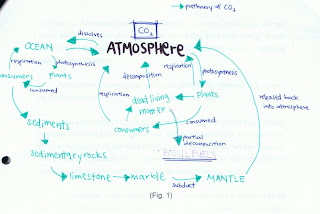Tuesday, May 19, 2009
Well, Pei Xin asked this question in class one day: Have we ever thought about why physical geography is put under Integrated Sciences? I thought it would be interesting to summarise this blog with this question as well as some other facts and notes about what we have learnt. Of course, the stuff I put up here are just really brief summaries of what we learnt, so everyone better go and mug still!I remember Mr Heah once said, physical geography is a science on itself. Earth science. Maybe that’s why it is put under IS? Physical geography studies more of the features on Earth. For example: volcanoes, atmosphere, hydrosphere, rivers etc. If you all paid close attention, actually within all these features/topics, science is very important. It’s all about how everything works in a system. Once you understand one part, and link it up with other parts, there you have it! Everything linked up together which makes perfect sense. I feel that science is more on how things work as well as why things work. How they happen, and why they happen. That’s mainly the reason why I think physical geography’s under IS.
Okay, now for the summaries.
 So here's basically like the rough idea that we need to study according to Pei Xin.
So here's basically like the rough idea that we need to study according to Pei Xin.HYDROSPHERE:
ALL THE BEST PEOPLE FOR GEOGRAPHY!!
- joanne
Tuesday, May 5, 2009
The geo test will be on week 10The following topics will be tested:
Atmosphere:
Climographs
Seasons
Climates
Rain/clouds formation
Hydrosphere
Water cycle
Water balance
Hydrographs
Features-formation
do revise all these and jiayou for your test :)
xingru
River features: Waterfalls, meanders and braidings
This post is about the content of two lessons which are on 28th of April and 29th of April.Definition: A waterfall is a sudden step in a river's long profile.
Reasons for its formation: The main reason for the formation of a water fall are different bands (layer) of rocks through the bed of a river. When a river is flowing on the ground, it will erode the rock band on its bed. If this erosion happens on the cross section of different layers of rocks, a difference in erosion will occur because of the different hardness of different kind of rock. Therefore, when the river flow through from a harder rock band to a softer rock band, a steep step will be formed because of the difference in erosion. This is how waterfalls are formed.
Meader
Definition: Meaders are the wind and curve features through river's' course. Meaders are brobably the most common river feature.
 Reasons for its formation: Meanders are formed mainly because of the riffles and pools in rivers. Riffles and pools are the shallower and deeper part of a river's bed. Water will never flow straight so that rivers will be twisted even if they are straight originally. When water flow through riffles and pools, a Helicoidal flow will occur because of the differences in velocity of river flow.
Reasons for its formation: Meanders are formed mainly because of the riffles and pools in rivers. Riffles and pools are the shallower and deeper part of a river's bed. Water will never flow straight so that rivers will be twisted even if they are straight originally. When water flow through riffles and pools, a Helicoidal flow will occur because of the differences in velocity of river flow.Helicoidal flow
 (From: https://blogger.googleusercontent.com/img/b/R29vZ2xl/AVvXsEiqYbUWm3cgEjyX-XsV7Hz7sL7GA1KLcTGfhHdLy_KOvivAIUz1jSwutXc6fUmahBquwYrDLNMRgQICQ06D8uRnvb7XbGW7MN5BN-l7b54R4GXAFQ71BsctvoA2HQFhX-IifpBFnId-aoU/s320/helicoidal+flow+3.jpg)
(From: https://blogger.googleusercontent.com/img/b/R29vZ2xl/AVvXsEiqYbUWm3cgEjyX-XsV7Hz7sL7GA1KLcTGfhHdLy_KOvivAIUz1jSwutXc6fUmahBquwYrDLNMRgQICQ06D8uRnvb7XbGW7MN5BN-l7b54R4GXAFQ71BsctvoA2HQFhX-IifpBFnId-aoU/s320/helicoidal+flow+3.jpg)Helicoidal flow is a cockscrew movement of water responsible for moving eroded river load from the outer bank and then depositing much of it on the next inner bank of a river. When helicoidal flow happens, river will start to shift outwards. This will make the river even more winded. Meanders will finally be formed by the during the process of helicoidal flow.
 (From: https://blogger.googleusercontent.com/img/b/R29vZ2xl/AVvXsEiBKnzSXd_ch0M7CSTUY2jjh1ztAhBDhcwkI52CTN7edcatcsjB12q008tDZM1lYCaQ0gP7_p-auOsGieVx_sGc0zUmWiOjmsfMVFPv-if-44cfAFMGQ50CFb5JeHV-nNHTqJmUBX7y2VU/s1600/helicoidal+flow+2.bmp)
(From: https://blogger.googleusercontent.com/img/b/R29vZ2xl/AVvXsEiBKnzSXd_ch0M7CSTUY2jjh1ztAhBDhcwkI52CTN7edcatcsjB12q008tDZM1lYCaQ0gP7_p-auOsGieVx_sGc0zUmWiOjmsfMVFPv-if-44cfAFMGQ50CFb5JeHV-nNHTqJmUBX7y2VU/s1600/helicoidal+flow+2.bmp) (From: http://www.ucpress.edu/books/pages/6664/moj01a.jpeg)
(From: http://www.ucpress.edu/books/pages/6664/moj01a.jpeg)Braiding
Definition: Braidings are formed when a river subdivides into many smaller streams within its channel.
 (From:http://www.braidedriver.net/braided_river_blue.jpg)
(From:http://www.braidedriver.net/braided_river_blue.jpg)Reasons for its formation: There are two resons for the formation of braidings. One is the easily erodable channel sides and the other is the highly irregular discharges. Easily erodable channel sides make it easier for water to erode out different routes or gaps. And irregular discharges make it possible for water to have different velocity and baseflow. A different route of water flow may be formed when there is a change in velocity and base flow. This will make up some small island in the river. And this is how braidings are formed.
 (From: http://www.gly.uga.edu/railsback/1121RiverOxBow.jpeg)
(From: http://www.gly.uga.edu/railsback/1121RiverOxBow.jpeg)The picture above is the formation of a Ox-Bow Lake. It also reflected the effect of different discharge. In the third picture, a braiding is formed because of the larger discharge in that period.
Poster: JAY ZHAN WEI HENG










